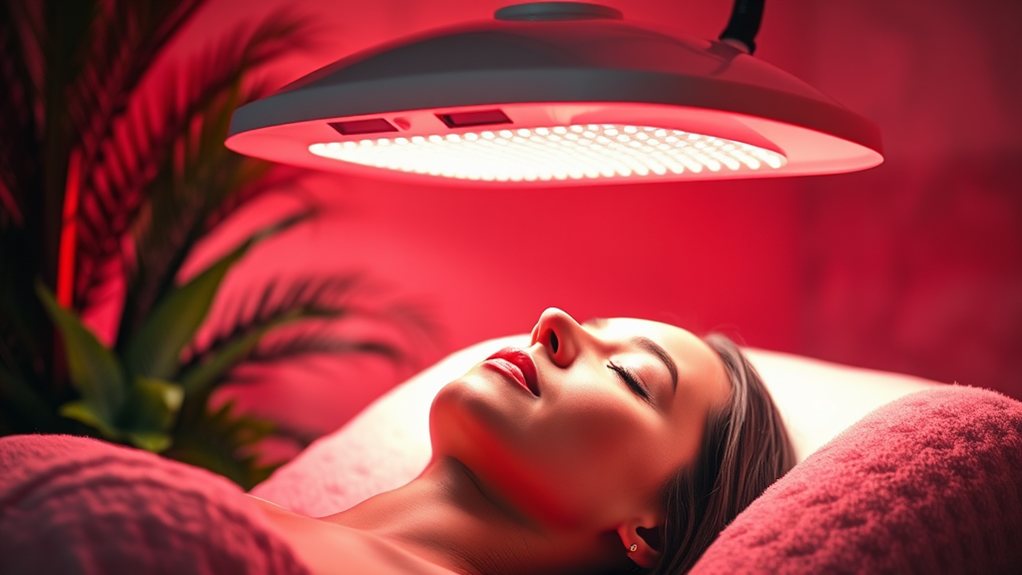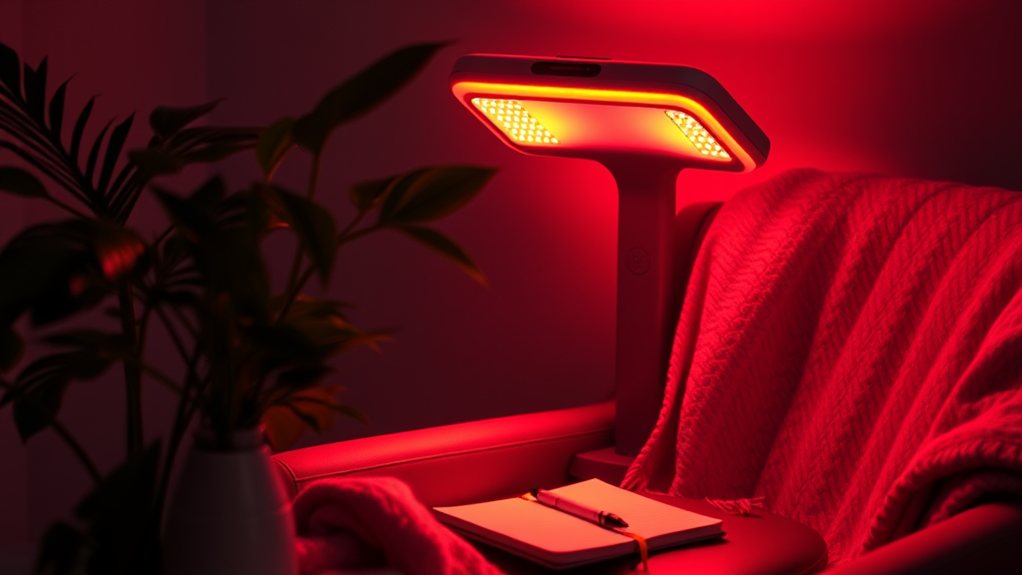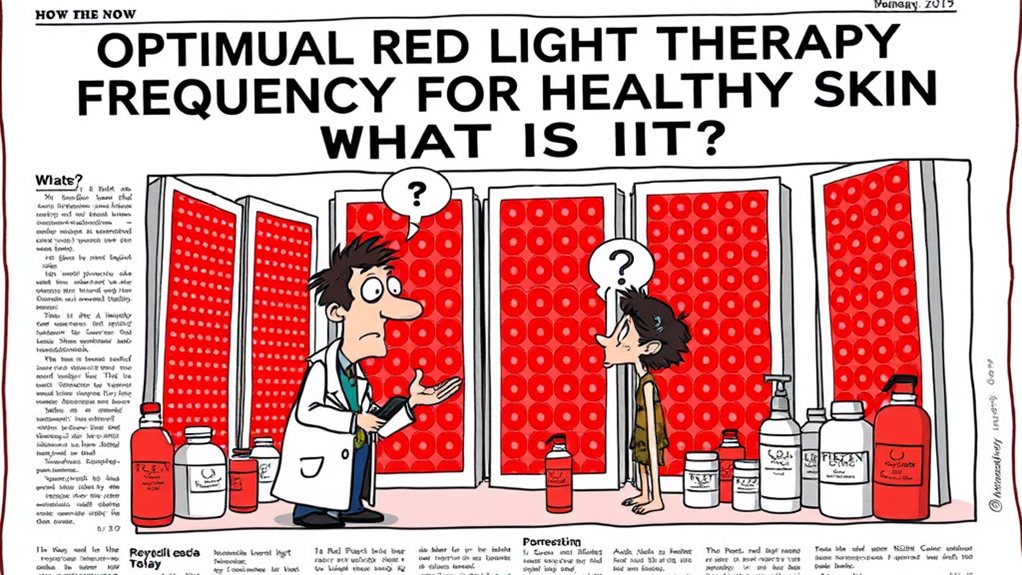For ideal red light therapy frequency, you should aim for two to five sessions each week, depending on your specific skin concerns. If you're addressing acne, three to five sessions can help reduce inflammation. For anti-aging, two to three weekly sessions can stimulate collagen production. Remember, consistency is essential, and it's important to monitor how your skin reacts to adjust as needed. Discover more about maximizing your results and tailoring your routine to your unique skin.
Key Takeaways
- For acne treatment, aim for three to five sessions per week to reduce inflammation effectively.
- For aging skin, two to three sessions weekly can stimulate collagen production.
- Consistency is crucial; monitor your skin's response to adjust the frequency as needed.
- Skin type, age, and severity of conditions influence the optimal frequency of therapy.
- Each session should last 10-20 minutes for optimal results; combine with hydration and sunscreen for enhanced benefits.
Understanding Red Light Therapy: How It Works

Red light therapy (RLT) employs specific wavelengths of light for stimulating cellular processes in the skin. By targeting the mitochondria, RLT improves ATP production, which fuels cellular activities.
This mechanism overview reveals how RLT promotes repair and regeneration at the cellular level. You'll find that these cellular effects include enhanced collagen synthesis and increased circulation, which contribute to healthier skin.
As the light penetrates your skin, it triggers biochemical responses that can lead to reduced inflammation and accelerated healing. Understanding this process helps you appreciate how RLT can be an effective tool in your skincare routine.
Benefits of Red Light Therapy for Skin Health
The advantages of red light therapy for skin health are well-documented, showcasing its effectiveness in promoting various aspects of skin wellness.
Red light therapy is a proven method for enhancing skin health and promoting overall wellness.
This innovative treatment can help you achieve a radiant complexion and improve overall skin quality.
- Stimulates collagen production, leading towards firmer skin
- Boosts skin rejuvenation by reducing fine lines and wrinkles
- Improves skin texture, promoting a smoother appearance
- Aids in healing acne scars and other blemishes
- Reduces inflammation and redness for an even skin tone
Recommended Frequency for Different Skin Concerns

When determining the ideal frequency of red light therapy for various skin concerns, it's crucial to take into account individual needs and specific issues.
For acne treatment, using red light therapy three to five times a week can effectively reduce inflammation and bacteria on the skin, leading to clearer complexions.
If you're targeting aging skin, think about sessions two to three times weekly. This frequency helps stimulate collagen production and improve skin elasticity, resulting in a youthful appearance.
Remember, consistency is key, and you should monitor your skin's response to adjust the frequency as needed.
Don't hesitate to consult a skincare professional to tailor the treatment to your unique needs and achieve ideal results.
Factors Affecting Red Light Therapy Frequency
Understanding the factors that influence red light therapy frequency can greatly improve your treatment outcomes. Your skin type and specific treatment goals play significant roles in determining the ideal frequency.
Here are some key considerations:
- Skin Type: Oily, dry, or sensitive skin may require different frequencies.
- Age: Younger skin might respond differently compared to mature skin.
- Condition Severity: More severe skin issues may need more frequent sessions.
- Desired Results: Whether you're aiming for anti-aging or healing affects timing.
- Device Quality: The effectiveness of your red light device can impact frequency.
Tips for Incorporating Red Light Therapy Into Your Routine

Incorporating red light therapy into your skincare routine can improve your results considerably, especially when you strategically plan your sessions.
Start by choosing a specific time each day for consistency; this helps your skin adapt to the treatment. Aim for sessions lasting 10-20 minutes, as research suggests this duration optimizes cellular response.
Think about combining red light therapy alongside other beneficial practices, like hydration and sunscreen application, to boost skin health.
Also, be mindful of your skin type; sensitive skin may require less frequent sessions.
Finally, document your experience. Tracking your reactions can help you understand how red light impacts your skin, fostering a sense of community among others who share similar goals.
Monitoring Your Progress and Adjusting Frequency
As you begin your red light therapy journey, monitoring your progress is crucial for optimizing results and adjusting the frequency of your sessions accordingly.
Regular progress tracking helps you evaluate the benefits and determine if adjustments are necessary. Here are some key aspects to reflect upon:
- Skin texture improvement: Notice any changes in smoothness or elasticity.
- Reduction in fine lines: Track changes in the appearance of wrinkles.
- Even skin tone: Monitor pigmentation and redness.
- Healing response: Observe any quicker recovery from blemishes.
- Energy levels: Assess overall well-being and mood after sessions.
Frequently Asked Questions
Can Red Light Therapy Be Used on All Skin Types?
Yes, red light therapy is compatible for all skin types. Its treatment effectiveness remains consistent across various skin tones, helping to improve skin health without adverse effects, making it a versatile option for everyone.
Are There Any Side Effects of Red Light Therapy?
Wondering about red light therapy risks? While most people experience minimal side effects, some may notice mild redness or irritation. It's crucial to consult a professional to guarantee safe and effective treatment tailored to your needs.
How Long Does Each Red Light Therapy Session Last?
Each red light therapy session typically lasts 10 until 20 minutes, depending on your specific needs. Maintaining consistent treatment intervals helps maximize benefits, ensuring your skin receives the ideal exposure for rejuvenation and healing.
Can I Combine Red Light Therapy With Other Treatments?
Imagine a garden thriving with diverse plants. You can combine red light therapy alongside other treatments for improved benefits, creating a harmonious synergy that nurtures your skin, fostering a sense of belonging in your self-care journey.
Is Red Light Therapy Safe for Sensitive Skin?
If you have sensitive skin, you can safely use red light therapy. Many experience therapy benefits like reduced inflammation and improved healing. Always start with shorter sessions and consult a professional to guarantee ideal results.
Conclusion
Incorporating red light therapy into your skincare routine can greatly improve your skin health. Studies show that regular sessions can increase collagen production by as much as 200%, enhancing skin elasticity and reducing fine lines. By understanding the ideal frequency tailored to your specific skin concerns and monitoring your progress, you can achieve noticeable results. Remember, consistency is key, so find a schedule that works for you and stick to it for the best outcomes.
